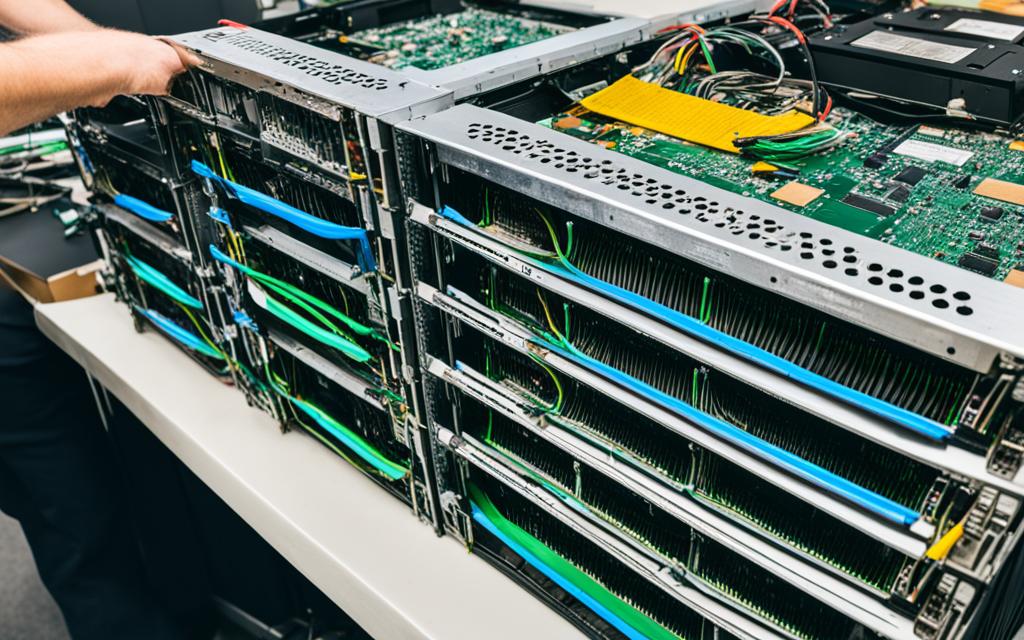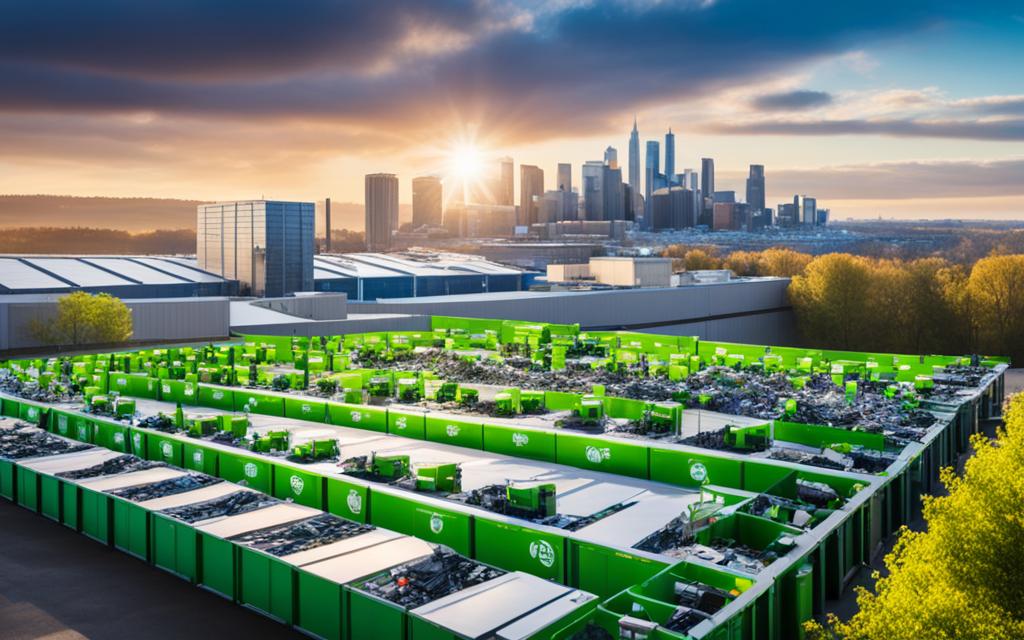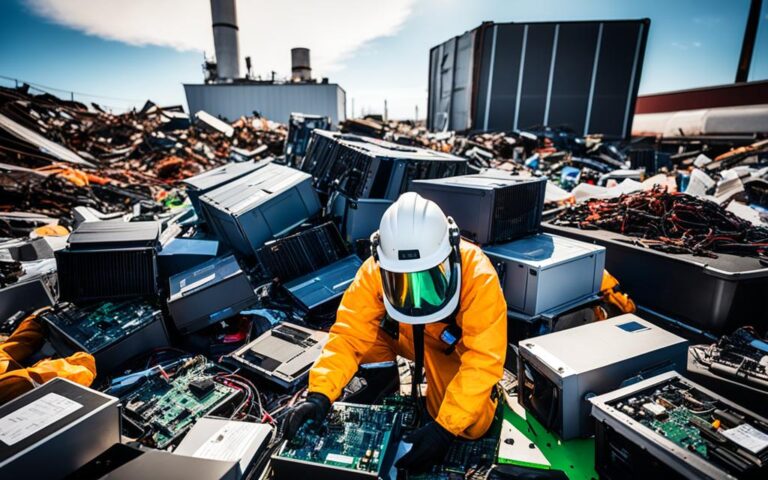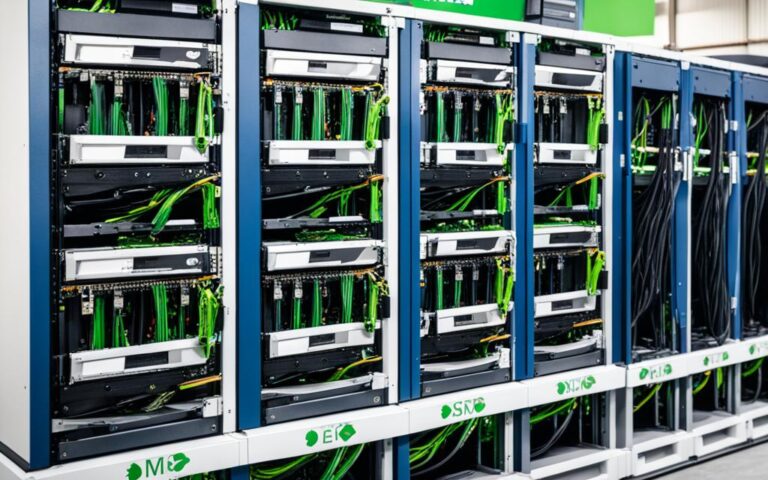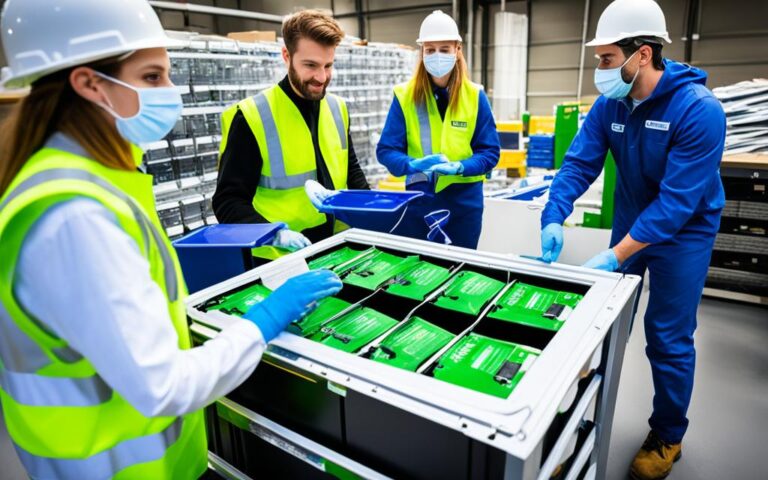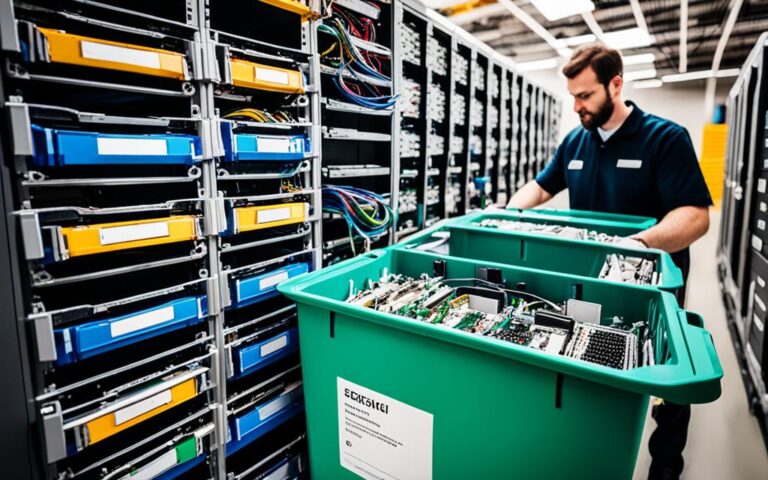Server Recycling: A Key Component of Green IT Strategies
Green IT, or green information technology, is the practice of creating and using environmentally sustainable computing resources. It aims to minimize the negative effects of IT operations on the environment by designing, manufacturing, operating, and disposing of servers and other computer-related products in an environmentally friendly manner.
Green IT practices include reducing the use of hazardous materials, maximizing energy efficiency, and promoting the biodegradability of unused products. Server recycling is an essential component of green IT strategies as it helps to minimize electronic waste and promote sustainability in the tech industry.
By recycling servers, organizations can reduce the environmental impact of their IT operations, lower carbon emissions, and contribute to a greener future. Implementing green IT strategies, including server recycling, is crucial for businesses in the UK to promote eco-friendly change and adopt sustainable tech practices.
What is Green IT and Why is it Important?
Green IT, also known as green information technology, is the practice of creating and using environmentally sustainable computing resources. It involves designing, manufacturing, operating, and disposing of servers, PCs, and other computer-related products in an environmentally friendly manner. The motivations behind green IT practices include minimizing negative effects, maximizing energy efficiency, and promoting biodegradability of unused products.
Green IT is important for several reasons. Firstly, it helps to address climate change by minimizing IT emissions and contributing to broader climate strategies in businesses. By adopting green IT practices, organizations can play a significant role in reducing their environmental impact and promoting sustainable practices.
Secondly, implementing green IT enables businesses to comply with government regulations regarding environmental sustainability. By following the guidelines and standards set by regulatory authorities, organizations can ensure they meet the necessary compliance requirements and reduce their environmental footprint.
Lastly, green IT can provide organizations with a competitive advantage. Consumers, prospective employees, and investors are increasingly prioritizing environmental, social, and governance practices when making decisions. By embracing green IT, businesses can attract and retain customers who value sustainability, appeal to job seekers who seek environmentally responsible employers, and attract investors interested in supporting companies that prioritize social and environmental causes.
Implementing green IT strategies, including server recycling, offers a wide range of benefits, both socially and environmentally. Organizations can enjoy reduced emissions, less waste, cost savings, raised awareness, improved corporate culture, sustainable product design, improved reputation, and increased customer satisfaction and loyalty.
Benefits of Green IT:
- Reduced emissions: Green IT practices help minimize IT emissions, contributing to climate change mitigation.
- Less waste: By maximizing energy efficiency and promoting biodegradability, green IT minimizes the generation of electronic waste.
- Cost savings: Energy-efficient practices can lead to significant cost savings for businesses.
- Raised awareness: Implementing green IT strategies can raise awareness about environmental sustainability among employees and the general public.
- Improved corporate culture: Green IT fosters a culture of environmental responsibility and sustainability within organizations.
- Sustainable product design: Embracing green IT encourages the development of environmentally friendly and sustainable products.
- Improved reputation: Organizations that prioritize green IT can enhance their reputation by demonstrating their commitment to environmental sustainability.
- Increased customer satisfaction and loyalty: Customers are more likely to support and remain loyal to companies that prioritize sustainability.
“Green IT is not just about reducing environmental impact; it’s about embracing innovation and creating a more sustainable future.” – Emma Green, Sustainability Expert
Green IT in Action: A Case Study
Company XYZ, a leading tech firm, recognized the importance of green IT and decided to implement various strategies to reduce its environmental impact. The company invested in energy-efficient servers and implemented a server virtualization initiative, resulting in significant energy savings and reduced IT emissions.
To promote biodegradability, Company XYZ partnered with recyclers and ensured proper disposal of electronic waste. They also adopted sustainable procurement practices by sourcing computer-related products from suppliers with strong environmental credentials.
The efforts of Company XYZ to adopt green IT practices not only helped them reduce their carbon footprint but also enhanced their reputation as an eco-friendly and socially responsible organization. They attracted environmentally conscious customers and key talent, giving them a competitive edge in the market.
By embracing green IT, Company XYZ has demonstrated its commitment to sustainability, contributing to a greener future and inspiring other businesses to follow suit.
| Conventional IT | Green IT | |
|---|---|---|
| Energy Consumption | High | Low |
| Electronic Waste | Significant | Minimized through recycling and proper disposal |
| Environmental Impact | High emissions and resource consumption | Reduced emissions, resource conservation |
| Costs | Higher energy bills | Lower energy costs and potential cost savings |
| Competitive Advantage | Limited | Attracts customers, employees, and investors with sustainability values |
The Impact of Existing Technologies on the Environment
Different types of IT hardware have varying negative effects on the environment throughout their lifecycle. It is important to understand how these technologies impact the environment to develop sustainable solutions.
Data Center Systems
Data center systems, including lighting, security, and power management, consume a significant amount of energy and contribute to greenhouse gas emissions. The continuous operation of data centers requires a substantial amount of electricity, leading to a high carbon footprint. Efforts are being made to improve the energy efficiency of data centers, but more needs to be done to minimize their environmental impact.
Networking Equipment
Networking equipment, such as routers, switches, and servers, also consume energy for information transmission. These devices play a vital role in data transfer between various entities, but their energy consumption contributes to carbon emissions. Energy-efficient networking solutions and optimized data transfer protocols can help reduce their impact on the environment.
Data Storage Devices
Data storage devices require energy for data transfer over networks and can contribute to storage waste. Inefficient storage practices lead to a larger amount of energy being consumed for data retrieval and processing. Implementing storage optimization techniques and utilizing sustainable storage solutions can help reduce the environmental impact of data storage devices.
End-User Devices
End-user devices like desktop computers, laptops, and smartphones also contribute significantly to carbon emissions. These devices are frequently replaced, resulting in a large amount of electronic waste. Promoting the use of energy-efficient devices, extending the lifespan of devices through maintenance and upgrades, and implementing responsible disposal practices can help mitigate their impact on the environment.
Computer Chips
Certain computer chips consume excessive amounts of energy, particularly graphics processing units (GPUs) used for AI and machine learning workloads. The demand for powerful computing capabilities in AI applications can lead to higher energy consumption and carbon emissions. Developing energy-efficient chips and optimizing algorithms can help reduce the environmental impact of AI-related computing.
Software
Software also plays a role in environmental impact, particularly data-intensive applications that consume significant energy. Improving software efficiency, optimizing algorithms, and adopting energy-saving programming practices can reduce the energy consumption associated with software operations.
Emerging Technologies
Emerging technologies like artificial intelligence and cryptocurrency mining are resource-intensive and have high carbon footprints. The computational power required for AI algorithms and the energy-intensive process of cryptocurrency mining contribute to increased energy consumption and emissions. However, these technologies can also be used to improve sustainability efforts. For example, AI-enabled data center monitoring tools can help reduce overall energy consumption and emissions, leading to a more efficient utilization of resources.
Understanding the environmental impact of existing technologies is the first step towards developing eco-friendly alternatives. By addressing the negative effects of IT hardware, we can work towards creating a more sustainable future.
How to Reduce Environmental Impact
To reduce the environmental impact of IT assets, organizations can take several measures. Firstly, they should measure their direct impact by using monitoring tools to track energy use and other sustainability metrics in data centers and throughout the supply chain.
Then, organizations can measure their indirect impact by considering the eco-friendliness of providers and business partners in their supply chain.
Goals should be set and frameworks, standards, and regulations should be utilized to optimize eco-friendly practices.
Energy efficiency can be improved by implementing virtualization, utilizing energy-efficient hardware, and promoting a culture of energy efficiency.
“Energy efficiency is not only beneficial for the environment, but it also results in cost savings for businesses. By using virtualization and energy-efficient hardware, organizations can significantly reduce their energy consumption and carbon emissions.”
Resource conservation and waste management can be achieved through techniques like virtualization, prioritizing water management, and implementing recycling programs for e-waste.
Sustainable procurement involves setting goals, evaluating current processes, and involving stakeholders from procurement, supply chain, and sustainability teams.
Recycling and disposal strategies should be developed, including partnerships with certified e-waste recyclers and disposal service providers.
“Implementing recycling programs not only helps organizations manage e-waste effectively but also contributes to the circular economy and reduces the need for raw materials.”
Finally, organizations can reduce their carbon footprint through various initiatives such as utilizing energy-efficient technologies, embracing telecommuting and remote work, and focusing on supply chain sustainability.
Supply Chain Sustainability
Supply chain sustainability involves assessing and optimizing the environmental, social, and economic impacts of the entire supply chain.
“By incorporating sustainable practices into the supply chain, organizations can minimize their environmental footprint, improve supplier relationships, and enhance their overall sustainability performance.”
Implementing these measures can help organizations make significant progress in reducing their environmental impact and contribute to a more sustainable future.
Conclusion
Implementing green IT strategies, including server recycling, is crucial for businesses in the UK to achieve sustainable tech practices and reduce their environmental impact. Green IT encompasses practices and technologies that aim to minimize the negative effects of IT operations on the environment. By recycling servers, organizations can contribute to the circular economy, reduce electronic waste, and lower carbon emissions.
Not only does green IT benefit the environment, but it also offers social and business advantages. Organizations can experience cost savings, improved corporate culture, and increased customer satisfaction. To reduce the environmental impact of IT assets, organizations should focus on energy efficiency, resource conservation, waste management, sustainable procurement, recycling and disposal, carbon footprint reduction, telecommuting and remote work, and supply chain sustainability.
By adopting these strategies, businesses can create a greener future and inspire eco-friendly change in the UK. To learn more about server recycling in the UK, visit the server recycling page on our website.
FAQ
What is Green IT?
Green IT, or green information technology, refers to the practice of creating and using environmentally sustainable computing resources. It involves designing, manufacturing, operating, and disposing of servers and other computer-related products in an environmentally friendly manner.
Why is Green IT important?
Green IT is important for several reasons. Firstly, it helps to address climate change by minimizing IT emissions and contributing to broader climate strategies in businesses. Secondly, it enables businesses to comply with government regulations and reduce their environmental impact. Lastly, green IT can provide a competitive advantage by attracting customers, prospective employees, and investors who value environmental, social, and governance practices.
What is the impact of existing technologies on the environment?
Different types of IT hardware have varying negative effects on the environment throughout their lifecycle. Data center systems, networking equipment, data storage devices, end-user devices, chips, software, and emerging technologies like AI and cryptocurrency mining can contribute to carbon emissions and resource consumption. However, these technologies can also be used to improve sustainability efforts, such as through AI-enabled data center monitoring tools that reduce energy consumption and emissions.
How can organizations reduce their environmental impact?
Organizations can take several measures to reduce their environmental impact. This includes measuring their direct and indirect impact, setting goals, utilizing frameworks and standards, improving energy efficiency, implementing resource conservation and waste management techniques, adopting sustainable procurement practices, developing recycling and disposal strategies, and focusing on reducing their carbon footprint through initiatives like telecommuting and remote work and supply chain sustainability.
Why should organizations consider server recycling?
Server recycling is a key component of green IT strategies as it helps to minimize electronic waste and promote sustainability in the tech industry. By recycling servers, organizations can reduce the environmental impact of their IT operations, lower carbon emissions, and contribute to a greener future.


